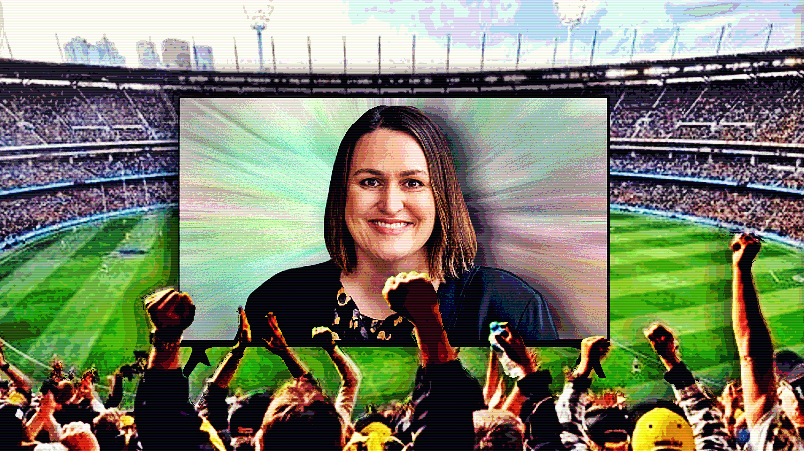‘Too easy to shit-can television’: Brands have ‘really strict old-school measurement KPIs’ restraining TV’s ‘industrial revolution’, says Seven’s Natalie Harvey – Unilever trial an early convergence benchmark
An Mi3 editorial series brought to you by
The Future of TV Advertising Forum and Mi3


Natalie Harvey: “The majority of television strategies are still very siloed. They're platform led versus being audience led."
Terrestrial television has been copping plenty of grief on its audience losses but Seven West Media’s national sales boss put some heat back on brand owners last week, challenging them to break old-world habits that are often levelled at TV networks. “You would be surprised how many brands don’t allow their agencies to deliver audiences across BVOD where the eyeballs are,” Natalie Harvey told the Future of TV Advertising conference last week. VOZ, she said, is no magic bullet.
What you need to know:
- Big TV advertisers have to adapt to new strategies to target TV audiences but many still operate on legacy performance benchmarks around terrestrial TV.
- The move to convergence across screens is showing up the problems with “siloed” audience strategies for advertisers.
- The imminent launch of unified linear and digital audience measurement via OzTam’s VOZ service will not change how people buy TV – an appetite to shake-up old TV buying habits needed to come first, per Seven’s Natalie Harvey.
- A trial with Unilever across free-to-air and digital streaming under an early VOZ trial had delivered a 20 per cent improvement in audience reach and duplication had been cut to four per cent.
- Multiple TV and video measurement systems will lead to “chaos” she warned, aligning with Nine’s Michael Stephenson as industry faces increasing risk of fracturing.
We know that if there's multiple platforms and multiple audience data points that people are using in sources of measurement, that chaos will ensue. And it's not a path that we can go down.
Convergence revolution
TV’s free-to-air audience declines and the migration of eyeballs to ad-free and ad-supported digital streaming services have grabbed the headlines. But many brands are not keeping up with the “convergence” revolution – Seven West Media’s Natalie Harvey reckons advertisers are still holding to a redundant “minimum TARP” rule “that has to go” and often demand their ads must be on linear free-to-air TV rather than a converged blend with BVOD.
“It’s really rigid. We’ve got to evolve how we’re thinking,” she said. “You'd be surprised at how many brands don't allow their agencies to deliver audience across BVOD where the eyeballs are. It has to be delivered in linear television, which just seems crazy when you've seen all the data and you can see where the audiences are. Put your brand where the audiences are.”
Unilever has historically been a big global TV advertiser which held to tight rules around buying TV but Harvey cited an early trial with Seven, Unilever and PHD with OzTam’s total TV VOZ measurement system – set to officially release on 1 May in which TV and broadcaster online audiences are unified. The consumer goods giant garnered a 20 per cent gain in reach over a straight linear TV campaign by using VOZ to target audiences across digital and linear. Audience duplication was four per cent on the “converged” campaign.
A lot of people will blame the delay in VOZ but I can assure you that having VOZ data from 1 May will not change how people buy television. Metrics have not evolved for the past 20 years. I see a lot of telly briefs and 95 per cent of them will have a traditional demographic, usually with a CPM a lot lower that what it should be.
Don’t blame VOZ
“The majority of television strategies are still very siloed,” Harvey said. “They're platform-led versus being audience-led. Since last year, audiences have continued to fragment but I would say strategic adjustments to adapt to those changes has been very slow or have been essentially quick fixes. A lot of people will blame the delay in VOZ but I can assure you that having VOZ data from 1 May will not change how people buy television. Metrics have not evolved for the past 20 years. I see a lot of telly briefs and 95 per cent of them will have a traditional demographic, usually with a CPM a lot lower that what it should be.”
Although VOZ acts as a catalyst for converged TV audience campaigns, it will require as much change from brand owners to adapt as TV networks. Unilever was an early benchmark on what was needed from advertisers, per Harvey. “What we did [with Unilever and PHD] was implement a campaign that mirrored consumption behaviour, not one that is siloed by platform. The results were incredible.”
Another warning on measurement chaos
There was much debate at the Future of TV Advertising forum on the fracturing of TV and video audience measurement currencies – Foxtel signalled its intent to shift away from TV ratings to digital-only metrics around impressions – but Harvey said the work Seven had done with 300 media planners and buyers underlines industry-wide concerns about measurement systems.
“There cannot be multiple platforms, there cannot be multiple sources of measurement,” she said. “There can only be one."
Amid the slew of headlines around free to air audience declines and ongoing delays to VOZ, Harvey suggested "it's almost getting a little bit too easy to shit-can television".
"I'm not ignoring the numbers, I'm acutely aware of it, I see it every single day. We know that if there's multiple platforms and multiple audience data points that people are using in sources of measurement, that chaos will ensue. And it's not a path that we can go down. We're not the US, we don't have 330 million people and they're a lot more complex in how they buy video," said Harvey.
"The best option is that we work with a gold standard and a platform and measurement system that has full transparency. I'm talking about VOZ and it's a couple of weeks away, providing everyone's aligned and we're all good to go. I think we'll see that the approach that OzTam has taken around making sure that the data is accurate will trump the approach of progress over perfection.”
Harvey’s comments aligned with a response from Nine’s Chief Sales Officer Michael Stephenson to Foxtel Media’s CEO Mark Frain who said his company “was making a bet on how we move away from old metrics on television to new metrics that are being applied to streaming TV. The faster we get to that side the better for our customers and our agencies.” Frain suggested delays to VOZ had created a metrics vacuum and that buyers are now actively seeking out alternatives.
Stephenson disagreed. He said supplementary data sets “makes sense” but if that results in multiple TV and video currencies it would “create complete chaos for everybody”.
Go bush
Harvey’s call-out for advertisers to modernise their approach to TV spilled over to how they viewed regional markets. “If I was buying media now, if I had a product to sell, I would be over investing in regional television,” Harvey said, with a caveat that she was not “just saying that because we own a regional network".
"What we have seen through regional networks is that the audience is fundamentally different. But you can also make sure that you get a competitive edge," said Harvey because 90 per cent of the market is yet to fully capitalise on integration.
"I'd say that only 10 per cent of brands that advertise in regional do something beyond spots and dots.”
